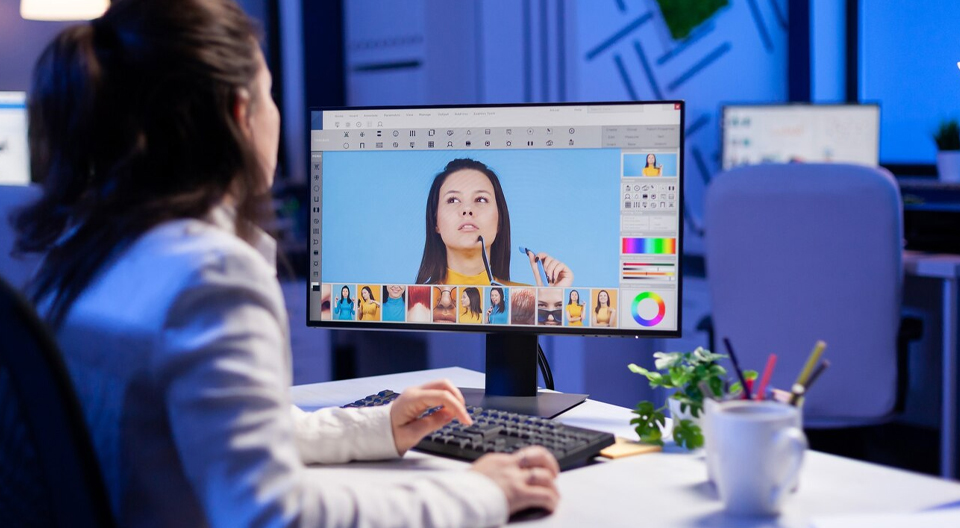
Introduction
In the fast-paced world of marketing, effective graphic designing can make all the difference. Visual content is at the forefront of brand communication, and businesses are continually seeking ways to enhance their graphic design strategies. In this blog, we’ll explore essential marketing advice for improved graphic designing, offering insights, tips, and best practices to help your designs stand out in a crowded digital landscape.
The Power of Graphic Designing
1. Graphic Designing: More Than Just Pretty Pictures
Graphic designing is more than just creating visually appealing images; it’s about conveying messages, emotions, and stories. A well-designed graphic has the power to captivate audiences, communicate brand values, and drive desired actions. In the context of marketing, effective graphic designing serves as a bridge between your brand and your target audience.
2. Visual Identity: The Foundation of Branding

Your brand’s visual identity is a cornerstone of its marketing strategy. Consistency in design elements such as logos, color schemes, and typography helps build brand recognition and trust. Your graphic designs should reflect and reinforce your brand’s personality, values, and goals.
3. Graphic Design in the Digital Age

The digital age has transformed the landscape of graphic designing. With the proliferation of websites, social media, and mobile apps, businesses have more opportunities than ever to connect with their audiences through visually engaging content. However, this also means that competition is fierce, making it crucial to produce exceptional designs that capture attention and leave a lasting impression.
Marketing Advice for Improved Graphic Designing
Know Your Audience: Design with Intention
Before diving into the creative process, take the time to understand your target audience. What are their preferences, needs, and pain points? Tailor your graphic designs to resonate with your audience, using colors, styles, and imagery that speak to their interests.
Simplicity Is Key: Less Is Often More
In graphic designing, simplicity is often more effective than complexity. Clean and uncluttered designs are easier to digest and resonate with audiences. Avoid overwhelming your designs with too much information or visual elements. Focus on conveying a clear and concise message.
Typography Matters: Choose Wisely

Typography plays a significant role in graphic designing. Select fonts that align with your brand’s personality and are easy to read. Pay attention to font size, spacing, and hierarchy to ensure that your message is easily digestible.
Color Psychology: Harness the Emotions
Colors have the power to evoke emotions and influence perceptions. Different colors convey different feelings, so choose your color palette thoughtfully. Consider the cultural associations of colors and how they align with your brand message.
Mobile-First Approach: Design Responsively
With the majority of internet users accessing content on mobile devices, it’s essential to adopt a mobile-first approach to graphic designing. Ensure that your designs are responsive and look great on screens of all sizes. Test your designs on various devices to guarantee a seamless user experience.
Consistency Is King: Brand Guidelines
Maintaining consistency in your graphic designs is vital for brand recognition. Create comprehensive brand guidelines that outline rules for logo usage, color schemes, typography, and design elements. Consistency across all marketing collateral helps reinforce your brand identity.
Storytelling through Imagery: Visual Narrative
Effective graphic designing often tells a story. Use imagery that aligns with your brand’s narrative and resonates with your audience. Images can evoke emotions, create connections, and convey messages more powerfully than words alone.
Embrace Minimalism: The Trendy Approach
Minimalistic designs are a growing trend in graphic designing. They focus on essential elements and remove any unnecessary clutter, resulting in clean, elegant, and visually appealing compositions. Consider adopting a minimalistic approach in your designs to keep up with current design trends.
User-Centered Design: UX Matters

Graphic designing goes beyond aesthetics; it also impacts user experience (UX). Ensure that your designs are user-friendly and intuitive. Prioritize accessibility by considering factors such as contrast, readability, and navigation.
A/B Testing: Optimize for Results
To maximize the effectiveness of your graphic designs, conduct A/B testing to determine which versions resonate best with your audience. Test various elements, such as colors, layouts, and calls to action, and use data-driven insights to refine your designs for better performance.
Stay Updated: Evolve with Design Trends
The world of graphic designing is ever-evolving. Stay up-to-date with current design trends and technologies. Being aware of emerging design tools and techniques can give your designs a competitive edge in the market.
Understanding Your Audience: Designing with Precision
Begin your graphic design journey by immersing yourself in your audience’s world. What are their preferences, pain points, and aspirations? Craft your designs with laser-like precision, aligning color schemes, styles, and imagery to resonate deeply with your target demographic.
The Beauty of Simplicity: Less Is Often More
Graphic design thrives on the principle of simplicity. Clean, uncluttered designs are easier to digest and resonate more profoundly with your audience. Avoid overwhelming your designs with an excess of information or visual elements. Focus on delivering a clear, concise message that leaves a lasting impact.
Typography’s Role: Choose with Deliberation
Typography isn’t a mere afterthought in graphic design; it’s a potent design element. Select fonts that harmonize with your brand’s essence and are legible. Pay meticulous attention to font size, spacing, and hierarchy to ensure seamless readability.
Colors as Emotion Elicitors: A Palette of Feeling
Colors possess the extraordinary power to evoke emotions and shape perceptions. Different hues stir different feelings, so select your color palette thoughtfully. Be attuned to cultural connotations of colors and how they align with your brand’s intended message.
The Mobile Imperative: Design Responsively
Given that most internet users access content via mobile devices, adopting a mobile-first approach is paramount in graphic design. Your designs should be responsive and visually appealing across screens of all sizes. Rigorous testing on various devices ensures a seamless user experience.
King Consistency: The Guiding Light of Brand Guidelines
Consistency is the bedrock of brand recognition. Create comprehensive brand guidelines that enshrine rules for logo usage, color coordination, typography, and design elements. Unwavering consistency across all marketing assets fortifies your brand’s identity and fosters trust.
Crafting Visual Narratives: The Art of Storytelling
Effective graphic design is a form of visual storytelling. Use imagery that seamlessly weaves into your brand’s narrative, evoking emotions and forming connections with your audience. Images possess the unique ability to convey messages more powerfully than words alone.
In the realm of marketing, graphic designing is a potent tool for connecting with your target audience, conveying your brand message, and driving desired actions. By following these marketing tips for improved graphic designing, you can create designs that not only captivate but also convert. Remember, designing with intention, simplicity, and consistency can elevate your brand’s visual identity and help you stand out in today’s competitive digital landscape. Embrace the power of graphic designing and watch your marketing efforts flourish as your designs leave a lasting impression on your audience.
Conclusion: Elevating Your Graphic Designing for Marketing Success
In the realm of marketing, graphic designing is a potent tool for connecting with your target audience, conveying your brand message, and driving desired actions. By following these marketing tips for improved graphic designing, you can create designs that not only captivate but also convert. Remember, designing with intention, simplicity, and consistency can elevate your brand’s visual identity and help you stand out in today’s competitive digital landscape. Embrace the power of graphic designing and watch your marketing efforts flourish as your designs leave a lasting impression on your audience.






